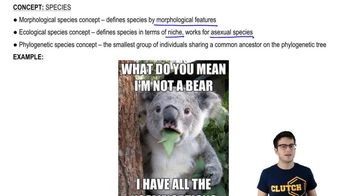Here are the essential concepts you must grasp in order to answer the question correctly.
Speciation
Speciation is the evolutionary process by which populations evolve to become distinct species. It often occurs when populations of a single species become isolated from one another, leading to genetic divergence over time. This can happen through mechanisms such as geographic isolation, where physical barriers prevent interbreeding, or reproductive isolation, where differences in mating behaviors or times inhibit gene flow.
Recommended video:
Natural Selection
Natural selection is a fundamental mechanism of evolution, where individuals with advantageous traits are more likely to survive and reproduce. This process leads to the gradual adaptation of species to their environments. In the context of speciation, natural selection can drive the divergence of isolated populations by favoring different traits that suit their specific habitats or ecological niches.
Recommended video:
Mutation and Genetic Variation
Mutations are changes in the DNA sequence that can introduce new genetic variations within a population. While many mutations are neutral or harmful, some can confer beneficial traits that enhance survival and reproduction. Genetic variation is crucial for evolution, as it provides the raw material upon which natural selection can act, ultimately leading to the emergence of new species.
Recommended video:
Sources of Genetic Variation



